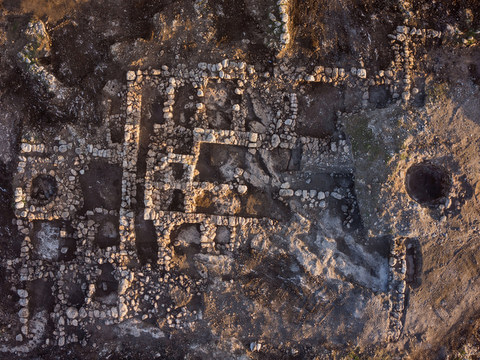The building from the Assyrian period (after the expulsion of the Ten Tribes) was uncovered in archaeological excavations by the Antiquities Authority before the expansion of Rosh Ha'Ain initiated by the Ministry of Construction * The farm will be preserved in situ for the public's welfare

An impressive 2,800-year-old farmhouse, which consisted of 23 rooms, was uncovered in recent weeks during archaeological excavations conducted by the Antiquities Authority in Rosh Ha'Ain prior to the expansion of the city, at the initiative of the Ministry of Construction. According to Amit Shadman, the director of the excavation on behalf of the Antiquities Authority, "the farm, which has been exceptionally well preserved, covers an area of 30x40 m, and was built in the 8th century BC - the period of the Assyrian occupation. The buildings of the farms during this period were used as a kind of small settlements, whose inhabitants took part in the processing of the agricultural produce. The many sherds discovered near the settlement indicate that the wine industry in the area was the main branch of agriculture there. A large silo, which was used to store grain, shows that the ancient inhabitants were also engaged in growing grain."
According to Shedman, the building continued to operate during the Persian period, also known as the return to Zion period (6th century BC), as well as during the Hellenistic period. This period began in Israel with the arrival of Alexander the Great, who was one of the greatest generals in the history of the ancient world. With Mokedon's victory over the Persian army in 333 BC, he began a very successful campaign of conquests. The journey to the Land of Israel did not encounter any special difficulties as far as Mokedon was concerned, and the Land opened its doors to the great Sabbat.
Evidence of a Greek presence in the area was uncovered on one of the building's floors, in the form of a rare silver coin on which the name of the commander is engraved - ΑΛΕΞΑNΔΡΟΥ. On this side of the coin you can also see the image of the god Zeus, while on the other side appears the head of Heracles.
In the Ottoman period, a lime kiln was mined into the building, for which the farm stones were used as an available raw material.
In light of the high level of preservation of the impressive building, the Antiquities Authority and the Ministry of Construction decided to preserve the building in situ, for the benefit of the city's residents and the traveling public.
Background on the area: The city of Rosh Ha'Ein is located on one of the necessary crossings of the 'Sea Road', which runs between the western slopes of Samaria - Dom Mount Samaria - and the ancient city of Antipatris - the sources of the Yarkon. This strategic location meant that throughout most of the historical periods, the place was a sought-after destination for settlement, both from the agricultural and military aspects. The human presence in the place already existed about 300 thousand years ago. As part of the development works carried out on road No. 5, a cave was unexpectedly discovered - 'Magic Cave' - with its multitude of findings that teach about the material culture of the inhabitants of the place. A few hundred thousand years later - during the Chalcolithic period - the remains of a settlement were identified on one of the banks of Nahal Raba, which runs through the city of Rosh Ha'Ein. A unique find was also uncovered from the Iron Age following archeological research and excavations conducted at the site of Zebat Certa located north of the city. This site is identified with the biblical touchstone. From the Second Temple period, we know that a large Jewish settlement operated in the Migdal Afek area, located south of the city. This settlement is reported by Joseph ben Matthiyahu in his writings when he discussed the area during the Great Revolt: "...and when he heard (Gloss) that quite a few Jews were concentrated in a tower called Afko, he sent a detachment there
in order to besiege them" (The Jewish Wars). Afek Tower actually continued to exist until modern times, and the area stood out mainly due to the extensive lime industry, which continued even more strongly from the Ottoman period.
